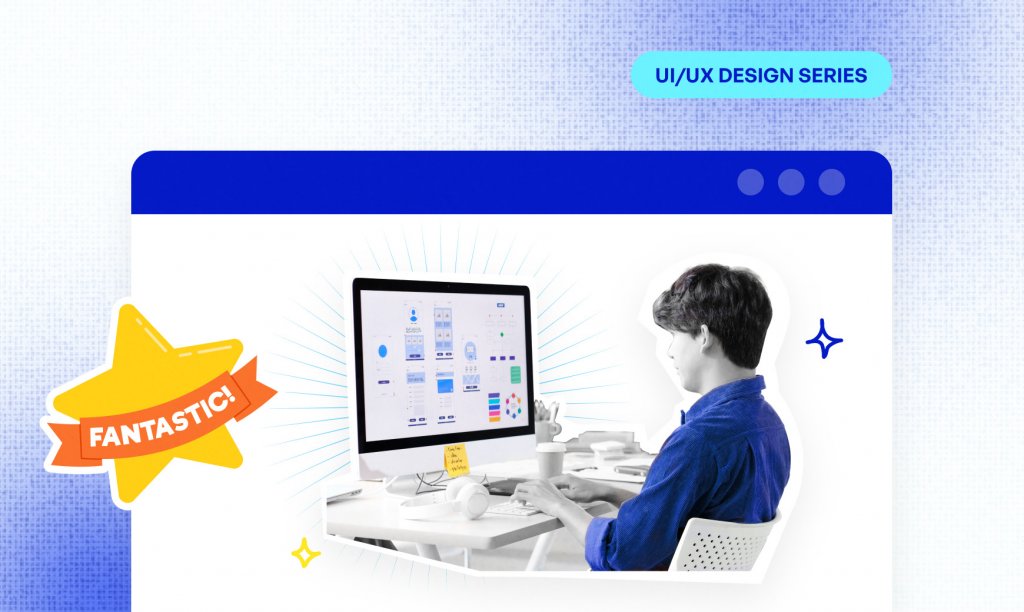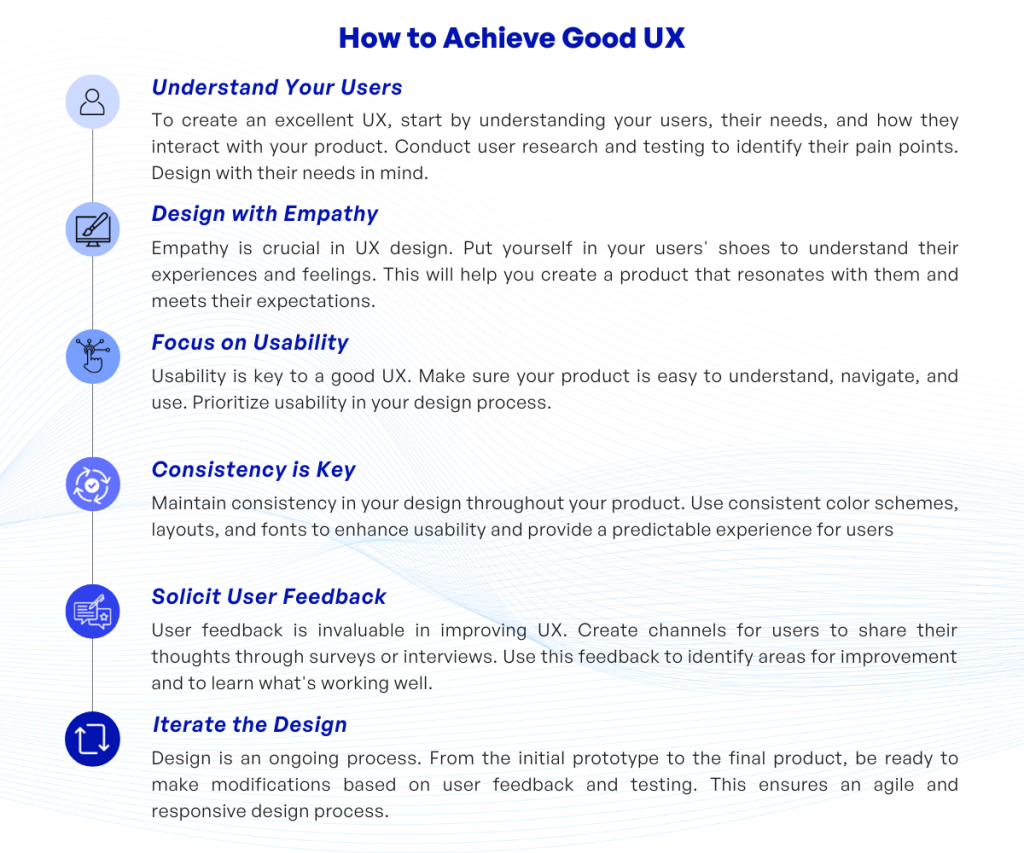
Did you know that 88% of online consumers are less likely to return to a website after a bad user experience? Now that’s a statistic that would grab any startup founder’s attention, isn’t it?
As the leader of your startup, UX (User Experience) design is more than just a buzzword you need to know. It is the lifeblood of any successful digital product. Why? Well, ponder over this.
UX design is about more than just creating an attractive interface. It’s about understanding the needs and problems of your users and providing them with solutions that are easy, convenient, and enjoyable to use. In short, good UX design = satisfied users.
If the statistic above is anything to go by, overlooking UX design is risky. It’s high time to understand its role and importance for your digital product.
Welcome, startup founders! Today we’re diving into the fascinating world of UX design. Have you been questioning what UX design is and why it’s vital for your digital product? Then, you’re in the right place.
1. What is UX Design?
Have you ever navigated through a website or mobile app and felt that everything was just where it should be? Your journey from one page to another was seamless and you intuitively found what you were looking for. That’s the magic of UX design, or User Experience design, at work.
Let’s unpack this a bit more. The ‘UX’ in UX design stands for ‘User Experience‘. UX design, at its core, focuses on crafting digital products that provide meaningful and relevant experiences to users. This involves the design process of integrating the product, including aspects such as branding, usability, functionality, and design.
So, as a startup founder, you’ll ask – what exactly does a UX designer do? A UX designer will focus on your product’s interactive and aesthetically pleasing elements. They’ll dive into in-depth user research to understand behavioral patterns, design user journeys, create wireframes and mockups, and perform usability testing.
In essence, UX design is about creating a digital environment that is user-friendly and aligns with user needs and expectations. It’s not merely about designing a product that looks good; it’s about making your user’s experience of your product as smooth and enjoyable as possible.
2. The Importance of UX Design in Product Development
Why does UX design matter in product development, you might ask? Well, let’s delve into this crucial topic. In the increasingly digital age, where customers are continuously interacting with various products and services online, the user experience (UX) plays a pivotal role in determining the success of your digital product.
First and foremost, UX design enhances customer satisfaction. When users interact with a product that’s easy to use, intuitive, and visually appealing, it translates into a positive experience. This, in turn, fosters customer loyalty and encourages repeat engagement.
UX design also directly impacts your startup’s bottom line. Remember this, a product with an optimized user experience leads to increased customer retention and acquisition. It’s simple, happy users are more likely to recommend your product to others, thereby gaining you more customers. Additionally, well-executed UX design can reduce development costs by identifying and resolving usability issues early in the development process.
Another major benefit lies in building your brand reputation. A product with a superb UX not only meets user expectations but goes beyond that, exceeding them, this is how you create memorable experiences. Now how does this help? When users have a memorable, positive experience with your product, they associate those positive feelings with your brand, thereby boosting your brand’s reputation and credibility.
Lastly, UX design assists in making data-driven decisions. UX strategies often revolve around conducting user research and gathering data to understand user behavior better. The insights gained from this data help in making informed decisions, thus ensuring that the product meets user needs and preferences.
So, it’s safe to conclude that the importance of UX design in product development simply can’t be overstated. In the upcoming sections, we will further explore the principles of a good UX design and how to achieve it. Stay tuned!
3. UX Design Process
So, you’ve realized the importance of UX design and now you’re likely wondering about the process. How exactly is UX design carried out? Hold onto your digital wheels, as we’re about to venture into the UX design process. Let’s discuss the typical stages that it usually involves.

3.1. Understanding the Problem Space and User Research
The first step in the UX design process begins with understanding the problem. What issue are your users facing? Accordingly, you kickstart user research. This involves interviewing potential users and gaining insight into their needs and preferences. Remember, the better you understand your users, the better your product’s UX will be.
3.2. Defining the User Persona
Once you’ve collected enough insights from your research, you’ll need to create a “persona” that represents your target user. This persona often contains specifics about their demographics, behavior patterns, motivations, and goals.
3.3. User Flow and Information Architecture
With a clear understanding of your users and what they need, you’re now ready to structure your website or app. Here’s where you start planning out the “navigation map” of your product— when and where users are likely to make certain actions. This is commonly referred to as Information Architecture. The User Flow, on the other hand, is brainstorming and deciding the path users take to accomplish a task within your product.
3.4. Sketching and Wireframing
Once the User Flow is defined, it’s time to get a bit visual. In this phase, you chalk out rough sketches (called ‘wireframes‘) of your product pages. Think of wireframes as the skeletal framework of your product where you map out which element goes where.
3.5. Visual Design and Interaction Design
Now onto the fun part—you get to play with colors, images, typography, and other elements of visual design to bring your product to life. This is also the stage where you ponder how each element in your design interacts and responds to the user – that’s Interaction Design. These elements should work intuitively to provide a seamless experience for users.
3.6. Prototyping and User Testing
Last but certainly not least, you need to test your design. Create a working model (a prototype) and have it tested by real users. Their feedback allows you to find any weak points in your UX design and rectify them.
The UX design process is, in essence, a cycle—research, design, test, iterate. With each iteration, your UX design improves, bringing your product closer to what your users need.
4. How to Achieve Good UX
So, how do you achieve a good User Experience (UX) for your digital product? It’s not an exact science, nor is there a one-size-fits-all solution. Rather, it involves embracing a user-centric mindset and following best UX design practices. Let’s dig in and explore some actionable tips to create an outstanding UX for your startup’s product.

4.1. Understand Your Users
The first step to ensure an excellent UX is to understand who your users are, what they need, and how they interact with your product. You can perform user research and user testing to know their needs and pain points. The better you understand your users, the more effectively you can design for their needs.
4.2. Design with Empathy
Being empathetic towards users is essential in UX design. This means placing yourself in the shoes of your users to understand their experiences and feelings. It can help you to design a product that resonates well with them and meets their expectations.
4.3. Focus on Usability
A good UX is not just about making your product look nice; it’s more about making it usable. This involves ensuring that your product is easy to understand, navigate, and operate. Usability can make or break a user’s experience, so prioritizing it in your design process is crucial.
4.4. Consistency is Key
Consistency implies keeping your design uniform across your product. It can involve maintaining the same color schemes, layouts, and fonts, which will enhance usability and deliver a predictable and comfortable experience for the users.
4.5. Solicit User Feedback
User feedback is invaluable in improving UX. You should create channels, such as surveys or interviews, for users to express their thoughts about your product. This feedback not only helps to discover areas for improvement but also gives an insight into what’s working well and should be retained or enhanced.
4.6. Iterate the Design
Design is never a one-and-done process. It’s continuous and iterative. From the initial prototype to the final product, be prepared to make modifications based on user feedback and testing results to ensure an agile and responsive design process.
In conclusion, achieving a good UX is a blend of understanding users, designing with empathy, focusing on usability, staying consistent, taking user feedback, and iterating your designs. Taking these steps can propel your startup’s digital product to deliver an extraordinary user experience that sets you apart in the market.
5. Conclusion
In conclusion, it’s evident that UX design plays an indispensable role in the success of digital products. It’s not just about making products look appealing but driving user satisfaction with a product designed around the needs and wants of your user base. A successful UX design process involves understanding your users, designing with empathy, focusing on usability, maintaining consistency, soliciting user feedback, and iterating the design – it’s a loop that continues even after the product is launched.
As a startup founder, understanding and implementing good UX design methods can greatly enhance your product’s performance. It can also contribute to your brand’s credibility and reputation, resulting in higher user retention, lower bounce rates, and ultimately, an increased bottom line. Remember, UX design is a matter of designing an exceptional experience that resonates with your users.
Hopefully, this article has enlightened you on the importance of UX Design for your product and guided you in the process of achieving it. The digital world is moving fast, and UX Design is no longer an option, but a requisite. So, dive in, put the user first, and watch your product flourish!
If you have any questions about UX design, feel free to contact KVY TECH!


